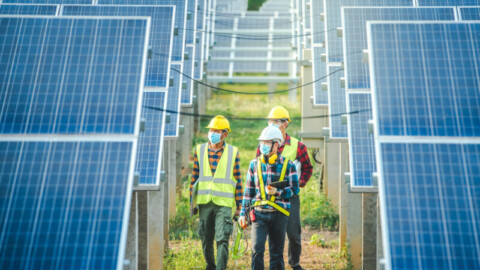by Jordan Oliver, Media and Public Affairs, United Energy
Voltage management has always been a key focus for electricity networks around Australia. With the explosion in growth of rooftop solar, managing voltage has become a greater challenge in recent years, with solar exports pushing voltage higher on local circuits in the middle of the day. In Melbourne, network business United Energy is tackling the issue head-on, proactively making changes to its network to maintain voltage within safe limits, while supporting the growth of rooftop solar.proactively making changes to its network to maintain voltage within safe limits, while supporting the growth of rooftop solar.
United Energy moves electricity to and from more than 700,000 homes and businesses across Melbourne’s south-eastern suburbs and the Mornington Peninsula. That’s more than 13,400km of wires, more than 215,800 poles and, increasingly, lots of rooftop solar.
Now, a new works program means more rooftop solar power will be able to be shared between homes and businesses within the network area, as part of United Energy’s major investment in its low-voltage electricity network.
The program will support the rise in rooftop solar installations by improving voltages and increasing the hosting capacity across the network to allow more solar to be exported back into the grid. Crews will complete over 500 individual items of work across 85 post codes, providing benefits for more than 40,000 homes and businesses.
The work is critical to maintaining voltage levels on the network through Victoria’s clean energy transition. General Manager Electricity Networks, Mark Clarke, said the upgrade program was an example of how United Energy was proactively supporting customers to get the most out of their solar as part of the network’s role as a distribution system operator (DSO).
“We’re seeing solar grow in popularity and with electricity costs continuing to rise, more households will be looking at ways to take control of their bills by investing in rooftop systems,” Mr Clarke said. “This work is about making sure our network is supporting our customers now and into the future invest in clean energy technology that will reduce carbon emissions.”
The number of households with rooftop solar increased by 15 per cent in United Energy’s network last year, with over 103,000 customers now having solar. A further 4,100 rooftop solar systems have been added to homes in the first five months of 2022. Rooftop solar capacity in the United Energy network now exceeds 550MW – more than Victoria’s largest gas-fired power generator.
Why voltage matters
Rooftop solar systems can create challenges for networks as they can push up voltage levels in the system. Similar to how water flows downhill, electricity flows from high voltage to low voltage. To enable solar panels to send excess power to other parts of the network, a solar system’s inverter needs to raise the voltage slightly to allow the electricity to flow out.
Networks like United Energy are required to deliver electricity to homes and businesses within a range of 216–253V. If the voltage is too high, customers may use more power than necessary, and potentially damage some appliances. If voltage is too low, customers may experience flickering lights and generally poor power quality.
“Our network is a critical gateway to Victoria’s energy future and managing rooftop solar and the impacts they can have on voltage levels is part of what we do every day,” Mr Clarke said.
“Whether it’s through upgrading our network or using smart technology to dynamically raise and lower voltages in real time across our network, we are optimally placed to continue supporting Victoria’s growth in consumer energy resources such as solar.”
In addition to the program, United Energy recently launched a new pre-approval tool for rooftop solar and home battery installations, ensuring the local network in each area can support customers to make the most of their new system. The pre-approval system assists in maintaining voltage compliance within each neighbourhood, ensuring solar exports are fairly and equitably available to all customers while reducing solar system outages and improving power quality.
Other initiatives
United Energy is further supporting solar installations by rolling out 40 innovative pole-top batteries in an Australia-first, with each battery capable of soaking up solar during the day and supporting entire neighbourhoods during peak times. It’s the largest rollout of community batteries in Australia and, when complete, the fleet of batteries will be able to store the electricity needed to support 3,000 homes as part of an $11 million investment in new energy technology.
The unique 30kW batteries on power poles are being installed over 18 months, each with the capacity to service up to 75 homes. Unlike big battery projects which provide grid level stability and electricity market outcomes, these smaller batteries are designed to help improve electricity reliability and enable greater solar PV exports in local areas where the low voltage distribution network is constrained.
Powerful neighbours
United Energy is also a key partner in a breakthrough study led by sister network Powercor, which has released its feasibility study into neighbourhood batteries called Powerful Neighbours.
The study found demand for action on issues such as carbon emissions reduction and climate change are the top reasons why both urban and regional communities are calling for neighbourhood batteries as part of their electricity distribution networks.
United Energy joined Powercor, as well as CitiPower and twelve community-based partners for the study, scanning more than 65 per cent of Victoria to identify 30 preferred locations for neighbourhood batteries.
Powerful Neighbours also identified insights into neighbourhood battery location, design and planning that can benefit future projects. It was developed with a major funding contribution by the Victorian Government’s Neighbourhood Battery Initiative.
The study found the chief benefits anticipated from neighbourhood batteries are in helping to enable and keep locally generated solar energy local, supporting high power reliability, generating income from wholesale energy trading or contributing to energy resilience.
Of the 30 preferred locations for neighbourhood batteries identified, 17 have the potential to be feasible based on their ability to address electricity distribution constraints and service more than 6,000 customers. Study partners identified 13 sites that could support community objectives.
The study has provided a solid foundation and framework for further detailed scoping and community engagement in relation to individual projects or groups of sites.

















